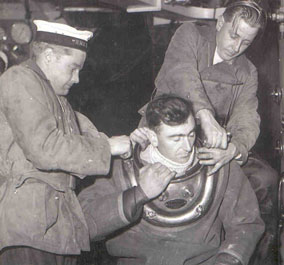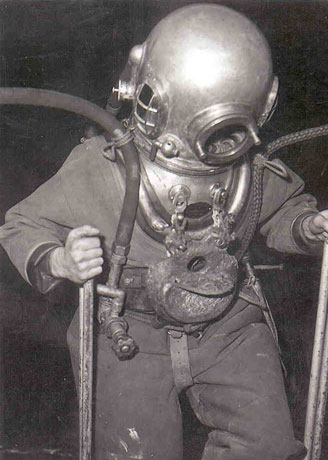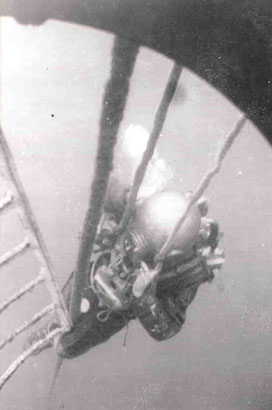
One Hundred Fathoms Down!
By David Strike
In 1956 Royal Navy Diver, George Wookey, descended to 600 feet. A record depth for a diver wearing standard flexible dress, and a feat of courage that remains unequalled.
Up until the 'sixties, the major advances in diving technology were driven by big budget, military programmes. Extending the depth limits to which a diver might safely go - and still be capable of performing meaningful work when he got there - had a practical purpose. It was a time when depth records, and the people who set them, were important. As much for what their achievements represented as for their individual accomplishment and courage.
Submarine rescue and recovery was the incentive behind the series of Deep Diving trials conducted by the British Admiralty during the 'thirties, 'forties and 'fifties. Setting out to extend the deep diving limits, the Royal Navy programme established a world depth record, in 1948, of 540-feet. Wearing a Siebe-Gorman six-bolt helmet incorporating the Davis Injector system, flexible dress, and using the fast dwindling supplies of American Lend-Lease helium, Petty-Officer Bollard had set a depth record that was to last eight years. Not until 1956 would the baton pass to another.
In October of that year, Senior Commissioned Boatswain George Wookey, descended to a depth of 600-feet, setting a record for a helmeted diver wearing flexible dress that still stands. Joining the Royal Navy as a boy, about a year before the beginning of World War II, George Wookey transferred to the submarine service, operating in the North Atlantic and English Channel before qualifying as a diver in August, 1944.
In 1948, Wookey was commissioned, and appointed to the Diving School in HMS Defiance to train "X" Craft crews in submarine escape and boom defence net penetration, until 1949 when he was sent to HMS Reclaim - the Navy's deep diving experimental ship for further deep diving training. A ship that he returned to again in 1951, to assist in the search for the sunken submarine, 'HMS Affray', in which seventy-five men lost their lives entombed inside the hull.
Perhaps as a natural consequence of a peacetime submarine disaster, there was an emphasis on trialing new methods of submarine rescue and recovery. In June, 1956, George Wookey found himself once more aboard, Reclaim, for trials of the Navy's new experimental one man observation chamber.
Although the preliminary work took place at various sites off the west coast of Scotland, the deeper trials were held in the fjords of Norway where the one-man observation chamber made 37 dives to depths between 400 and 1060 feet.

"At the same time that the chamber dives were taking place", recalls George Wookey, "a number of flexible suited dives using various mixtures of oxy-helium were made to moderate depths. The existing decompression tables, however, proved inadequate with a high proportion of the dives resulting in the bends.
"Clearly more investigation was necessary. A team of physiologists from the RN Physiological laboratory re-assessed the former data and by August 1956, a new set of tables for depths ranging from 300 feet to 600 feet were supplied."
At Fort William, in western Scotland, preliminary dives using the new tables proceeded normally and without incident. HMS Reclaim again set sail for Norway, arriving at Osterfjord on the 10th October, 1956.
"Despite bad weather, and the loss of one of Reclaim's four anchors while mooring in deep water, we began diving operations. Chief Diver Bob Linscott was the first to descend, with a scheduled depth of 450 feet.

"Although Linscott's decompression proceeded normally after his dive, all was not well. As the last few pounds of pressure were released from the SDC [Submersible Decompression Chamber - predecessor of the bells in commercial use today], the diver's attendant developed serious pain in both legs, and was lifted bodily out of the SDC and put straight into the ship's main RCC [Recompression Chamber] for therapeutic treatment. Four hours later Bob Linscott reported pain in both arms, and he, too, was bundled into the RCC for treatment.
"With the weather worsening, the Captain of Reclaim had little choice but to unmoor the ship and run for shelter in the lee of the little village of Arne. Overnight Surg Cdr Bill Crocker and physiologist, Ray Hempleman, worked yet again on the decompression tables, adjusting and extending them as necessary.
"On the morning of 12th October, the weather had moderated and the decision was made to continue with the trials. The ship was re-moored in 620 feet - albeit with 3 anchors - while diver Joe Helps dressed slowly and methodically in the tense atmosphere of the diving flat below decks.

"A heavy steel work bench was lowered to 450 feet and hung suspended by the shot rope down which the diver would descend. To simulate working on the hull of a submarine, Helps was to take down a wire hawser and attach it to the work bench with two shackles. The allowed time at this depth was ten minutes.
"Five hours later, after his dive to 450 feet, both Helps and his SDC attendant were none the worse for their dive.
"The date was still Friday, 12th October. Our deadline was Sunday the 14th October, on which day the ship was scheduled to depart for our home base in Portsmouth. It was important, since we had now achieved success at 450-ft., that we attempt to reach 600 feet - the main object of this series of experimental dives.
"The fact that this dive would have to be undertaken at night was of little consequence since there would be no material light - day or night - below about 200 feet.
"The decision taken, the work bench was lowered to 600 feet and two submarine lamps freely suspended from the bow of the ship to 260 feet and 600 feet, some 50 feet away from the work bench. A final analyses of the gas mixture in the main storage cylinders and by 19:15 hrs that same evening all was ready. "Normal deep diving routines for diving deeper than 300 feet was for the diver to make a normal descent on compressed air to 120 feet, then wait briefly at that depth while the composition of the breathing gas was changed to 9% oxygen, 91% helium. The diver would then continue with the descent to, in this case, 600 feet.
"Although I had been through precisely the same routines many times before, the atmosphere in the diving flat could, on this occasion, be felt more acutely. The blackness of the Norwegian winter night outside the diving doors in the hull of the ship, and the whine of the rising wind, lending drama to an otherwise normal scene."
With the preliminaries over and the routine tests completed, George Wookey entered the water and waited, half-floating, one foot on the bottom rung of the ladder and his helmet a couple of feet below the broken surface.
"I watched the SDC - with my attendant, diver 'Geordie' Clucas, inside - slowly leave the surface, bubbles gushing briefly from the opened lower hatch as the rising air pressure within kept out the invading water. Then suddenly the SDC vanished below me, the drone of the winch and the purchase wire, not two feet away, speeding it into the water to 220 feet, where Clucas would await my return from 600 feet."
"The order, "On to the shot rope and carry on down." boomed over my intercom. Sliding down to 120 ft took less than one minute and the order to, "Stop! Remove mouthpiece and start counting." came as no surprise, for this is where my normal air supply, ie Nitrogen/oxygen, would be substituted by the appropriate mixture of helium and oxygen.
"Helium is, of course, lighter than the nitrogen it replaces - approximately seven times lighter - and the vocal effects are quite startling. Ones voice changes completely, taking on a Donald Duck like quality that is difficult to interpret by those unaccustomed to it.
" "Regain mouthpiece and carry on down." came the next order.
"Already it was much colder as the helium permeated my system. As my descent continued toward the SDC, the glow from the first of the suspended lamps became much stronger.
"Within seconds my heavily booted feet were clanging on the side of the SDC where Clucas waited in his solitary confinement. He waved through the open lower hatch as I sped past, the light from within dazzling me briefly and then rapidly diminishing as I left it far above me.
"The water turned from a bright, crystal clear, green to a deepening opaque, then finally, and quickly, complete blackness. But a beautiful blackness illuminated by myriads of bio-luminescent plankton surging up at me.
"With all sense of time lost, it seemed as though I had been dropping for ages - rather like a childish nightmare where one seems to be falling through a bottomless chasm before suddenly awakening with a start.
"Gradually I found my descent slowing and my legs tending to float upwards as I slid down the shot rope and I realised that my new found buoyancy was due to the increasing length of umbilical hose being paid out by my attendants on the surface.
"I knocked hard on my relief valve inside the helmet, releasing as much gas as I could. Soon I could distinguish a faint, intermittent glow that increased steadily as I pulled myself down, hand over hand, to the work bench at 600 ft.
"At last I'd made it. "On the bottom." I reported. A remote voice jerked my mind back to the job in hand, "Your gauge depth is 600 feet. Carry on with your work.". The screwed shackles secured by the previous diver had been screwed up tightly and seized with rigging wire. My exposed hands were fast becoming numb. Cold crept steadily through me and I had a passing thought, "One of these days they'll invent heated suits!" [Water temperature in Norway in October, 1956, was approximately 1 deg. C. -Ed.]
"After what seemed a lifetime the job was done and I reported, "Job completed."
"The order, "Stand by to come up." reached me. I tried to clamber on to the top of the work bench but for some reason I was being restrained - the slack telephone breastrope secured to my helmet had caught under the suspended bench, and as those on the surface pulled so I was being dragged under the bench.
"After a frightening few minutes of struggle to clear myself and not being able to make myself understood over the intercom, I was, at last, free and hung there, briefly exhausted, before the long ascent to my first decompression stop at 260 feet."
"This was to take 12 minutes, and allowed plenty of time for reflection: Thankful that I had been able to pull myself clear of the bench; elated that we had been able to prove that a diver could do useful work, possibly vital to a damaged submarine, under difficult conditions at 600 feet,. And finally that I'd achieved a personal ambition of many years standing.
"The increasing cold brought me back to reality. I'd never been so cold in my life and my exposed hands were really hurting. My fingers seemed swollen to the size of sausages.
"By 10 feet stages I reached 220 feet where I remained hanging on to the steel ladder suspended from the opened lower hatch of the SDC. After 10 minutes the SDC was raised to 210 feet where Clucas waited to assist me into the SDC.
" "Let me be the first to congratulate you, George!" he said as he removed my helmet - releasing air line and telephone breast rope from the helmet so that they might be pulled to the surface, then shutting the lower hatch and enclosing us both within the confined space of the SDC.
"At 200 feet the gas mixture reverted to oxy/nitrogen. The SDC was then hoisted inboard with Clucas and myself remaining inside to complete our tediously long decompression in ten-foot stages to 30 feet.
"At this depth - about the deepest one may, in safety, breathe pure oxygen, I stood, stretched and slipped the closed circuit oxygen apparatus around my neck.
Breathing pure oxygen would speed the elimination of nitrogen and any remaining traces of helium from my blood stream [by approximately 2 1/2 times]. It was now Clucas' turn to sit down and I felt thankful to stand for a while - not enough room for two to sit down anyway!
"The last decompression stop at 10 feet seemed interminable, but was in fact only 30 minutes. I had become numb to the discomfort after about six hours since leaving the surface and I was so cold!
"Slowly the pressure dropped to atmospheric and I stretched upwards to hammer the clips off the upper hatch of the SDC when, to my dismay, I felt the distinctive pain creeping along my arms and across my back. I felt transfixed and scared, having had several bends in the past, the last serious one having landed me in the hospital. I knew what a bend in the back could mean.
"Clucas scrambled over and past me and through the upper hatch. "Better haul him out quickly!" I heard him say. Four hands grabbed me by my upraised arms and yanked me bodily out of the SDC and I followed headlong into the main RCC after Clucas. The door slammed shut, compressed air screamed into the RCC and within seconds the quickly mounting pressure slowly began to relieve the now intense pain in my arms and back.
"Tired as I was I hated the idea of having to again breathe through a mouthpiece for an extended period of therapeutic decompression, but thanked God that these facilities were available. The relief I felt when the pain finally subsided and mobility returned to my arms and upper torso can only be imagined!
"Five hours later, at 07:35 on the 13th October, I crawled tiredly out of the main recompression chamber and into a hot tub in the sick-bay."
George Wookey had proven that it was possible for a flexible suited diver operating from the surface to do useful work perhaps vital to a sunken submarine, and in depths that just a few years previously was thought to be impossible. His efforts were rewarded with an M.B.E..
During 1957 the Royal Navy abandoned this form of deep diving as being too hazardous to the individual diver and concentrated their efforts instead on developing the principle of diving from a manned underwater capsule from which a diver could emerge at the operating depth on the end of a short umbilical whilst closely attended and observed from within the capsule.
"Such", says George Wookey philosophically, "is progress!"
---ENDS---
Panel Piece
The Siebe-Gorman Injector type equipment worn by George Wookey on his record-breaking descent differed from the standard [i.e. the Davis 6-bolt] diving dress, and was specially designed to reduce the carbon-dioxide content of the gas breathed by the diver to the minimum. The Deep Diving helmet is slightly larger than the ordinary, has connections for two 'air' pipes, neither of which is fitted with a non-return valve, and incorporates a special outlet valve to vent air quickly from the system.. Breathing gas enters the helmet through one connection and is guided over the front glass by a rubber air-chute. A mouthpiece fitted with a non-return valve enables the diver to inhale air from the helmet and to exhale through the mouthpiece. Expired gas exits through the second pipe and passes into a weighted canister containing a CO2 absorbent cartridge mounted on the divers back in lieu of the usual backweight. The 'scrubbed' gas then re-entering the helmet. A by-pass valve attached to the canister and mounted on the wearer's right hand side allows the diver to manually control the gas flow and determine whether gas enters the helmet directly or through the injector system.
---ENDS---
Photo Captions 1] View of Diver Wookey taken by Clucas from inside the S.D.C. 2] The Diving Crew who took part in the record breaking dive shortly after 'HMS Reclaim's" return to Portsmouth. [George Wookey, standing, arrowed] 3] Naval Experimental Observation Chamber. 4] [Rear. L to R] Linscott, Wookey. [Seated L to R] Joe Helps; Ron Maitland-Flanagan; Roger Compton; 'Bungy Edwards. 5] George Wookey Preparing to enter water for record breaking dive. 6] Galleazzi One man observation chamber 7] HMS Reclaim 8] George Wookey being dressed for record breaking dive. 9] HMS Reclaim undertaking Deep Diving trials at Loch Fyne. [Note SDC hanging over ship's side prior to lowering] Two